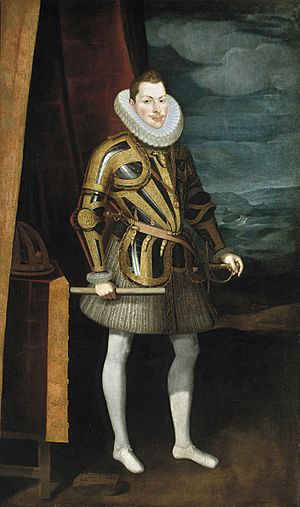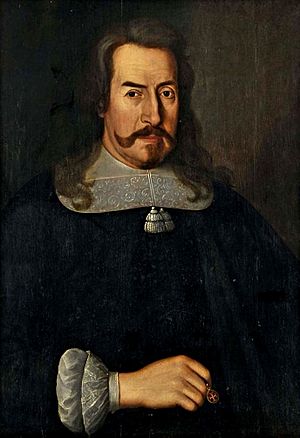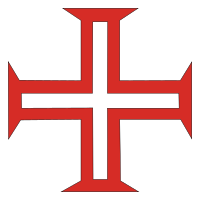Portuguese Restoration War facts for kids
Quick facts for kids Portuguese Restoration War |
|||||||||
|---|---|---|---|---|---|---|---|---|---|
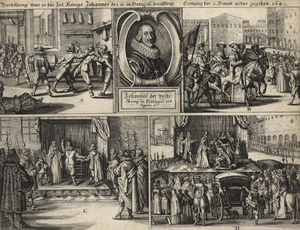 German engraving from the 1650s representing the episodes of the portuguese restoration of the independence. Clockwise from top left:
|
|||||||||
|
|||||||||
| Belligerents | |||||||||
|
|||||||||
| Commanders and leaders | |||||||||
|
|||||||||
The Portuguese Restoration War (called Guerra da Restauração in Portuguese) was a long conflict between Portugal and Habsburg Spain. It started with a revolution in Portugal in 1640 and ended with the Treaty of Lisbon (1668) in 1668. This treaty officially ended the Iberian Union, which was when Portugal and Spain were ruled by the same king.
From 1640 to 1668, there were many small fights and some bigger battles between Portugal and Spain. Both countries were also involved in other wars at the same time. Spain was fighting in the Thirty Years' War until 1648 and the Franco-Spanish War (1635–1659) until 1659. Portugal was fighting in the Dutch–Portuguese War until 1663.
In Portugal, this period of fighting was often called the Acclamation War. The war led to the House of Braganza becoming Portugal's new royal family. They replaced the House of Habsburg, who had ruled Portugal since 1580.
Contents
Why the War Started: Events Leading to Revolution
When Philip II of Portugal (who was also Philip III of Spain) died, his son Philip III of Portugal (Philip IV of Spain) took over. He treated Portugal differently. Portuguese merchants faced higher taxes. Portuguese nobles lost their power in the Spanish government. More and more, Spaniards took important government jobs in Portugal.
Philip III wanted to make Portugal just another Spanish province. This meant Portuguese nobles would lose all their power and influence.
Spain also pulled Portugal into its fight against the Dutch Republic during the Eighty Years' War. Because of this, the Dutch attacked Portuguese colonies and trading posts around the world. They either robbed them or took them over. This was known as the Dutch–Portuguese War. Portuguese people felt angry because they thought Spain was protecting its own colonies but not theirs.
All these problems led to a revolution. Portuguese nobles and wealthy citizens planned it. On December 1, 1640, the revolution began. This was 60 years after the first "dual monarch," Philip I of Portugal, had been crowned.
The plot was organized by Antão Vaz de Almada, Miguel de Almeida, and João Pinto Ribeiro. They and other people, known as the Forty Conspirators, killed the Secretary of State, Miguel de Vasconcelos. They also arrested the king's cousin, Margaret of Savoy, who was governing Portugal for him. At that time, Philip's troops were busy fighting the Thirty Years' War. They were also dealing with a rebellion in Catalonia, called the Reapers' War.
The people of Portugal quickly supported the revolution. Within hours, John, the 8th Duke of Braganza, was declared King John IV of Portugal. News spread fast across the country. By December 2, 1640, King John IV had already sent a letter to the city council of Évora.
This conflict with Spain brought Portugal into the Thirty Years' War as a minor player. From 1641 to 1668, Spain tried to isolate Portugal. Portugal, in turn, tried to find ways to stay independent. This included making alliances and keeping its income from its colonies.
Getting Ready for War
After becoming king, John IV quickly worked to make his position stronger. On December 11, 1640, he created a 'Council of War'. This council was in charge of planning all military actions. Next, the king set up the 'Junta of the Frontiers'. This group managed fortresses near the border, Lisbon's defense, and sea ports.
A year later, in December 1641, he created a special tax. This tax would pay for upgrading all the country's fortresses. He also reorganized the army. He brought back the 'Military Laws of King Sebastian'. King John also started a diplomatic effort to improve relations with England.
After some small victories, King John wanted to make peace quickly. However, Spain's King Philip would not recognize Portugal's new royal family. This recognition finally happened during the reign of John's son, Afonso VI. It was during the time when another of his sons, Peter of Braganza (who later became King Peter II of Portugal), was regent. The fighting with Spain lasted for 28 years.
Europe's Big Picture: How Countries Related
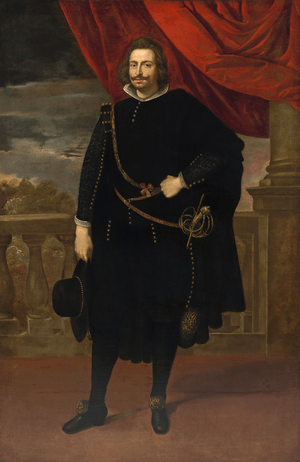
France and Spain's Relationship
In 1640, Cardinal Richelieu, a top advisor to Louis XIII of France, knew France was in a tough spot. France was at war with Spain. It also had to deal with rebellions inside France, which Spain supported. French armies were fighting the Spanish Habsburgs on three different fronts. Besides their shared border at the Pyrenees, Philip IV of Spain also ruled lands north and east of France. These included Flanders and Franche-Comté. Philip IV also controlled large areas in Italy. From there, he could attack French-controlled Savoy.
Spain was known for having the strongest military in Europe. But this reputation had lessened during the Thirty Years' War. Richelieu decided to make Philip IV focus on his own problems. To distract Spanish troops, Louis XIII, advised by Richelieu, supported John's claim to the Portuguese throne. They believed a war in Portugal would use up Spain's soldiers and money.
Portugal and France's Relationship
Portugal and France had common goals in foreign policy. So, they signed a treaty of alliance in Paris on June 1, 1641. This alliance lasted 18 years. Then, Richelieu's successor, Cardinal Mazarin, broke the treaty. He abandoned Portugal and its Catalan allies. He signed a separate peace with Spain. This was the Treaty of Pyrenees, signed in 1659. Under this treaty, France gained parts of Catalonia north of the Pyrenees. This area is known as Roussillon and part of Cerdanya. Most importantly for Portugal, France recognized Philip IV of Spain as the rightful king of Portugal.
Seven years later, near the end of the Portuguese Restoration War, relations between the two countries improved. The young (but often sick) Afonso VI of Portugal married a French princess, Marie Françoise of Nemours.
Portugal and the Dutch Republic's Relationship
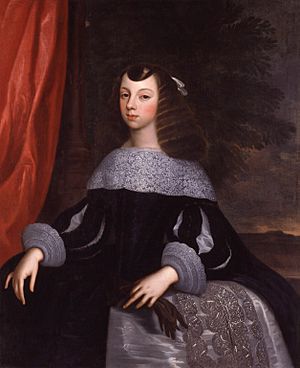
When the revolution happened in Lisbon on December 1, 1640, Portugal had been fighting the Dutch for almost 40 years. Much of this conflict was because Spain and the Dutch Republic were fighting the Eighty Years' War (1568–1648). Since 1602, Portugal had been ruled by a Spanish king.
The Dutch-Portuguese War was fought mostly overseas. Dutch trading companies, like the Dutch East India Company and the Dutch West India Company, attacked Portugal's colonies. These attacks happened in the Americas, Africa, India, and the Far East. Portugal was mostly defending itself and got little military help from Spain.
After John became king, the fighting continued across the Portuguese Empire. The Dutch were finally driven out of Angola (1648), São Tomé (1649), and Brazil (1654). The Dutch signed a truce with Portugal in Europe. They helped each other against their common enemy, Spain. The Dutch started buying salt from Setúbal again. This restarted trade between the two countries for the first time since 1580. That's when the Spanish Habsburgs, who the Dutch were rebelling against, took over the Portuguese throne. However, Dutch attacks on Portuguese lands continued until 1663. This was even after the Treaty of The Hague (1661) was signed in 1661.
Portugal and England's Relationship
England was busy with its own English Civil War at this time. Portugal faced problems with England because the English Parliament fought and won its war against the king. But Portugal's royal court continued to welcome and recognize English princes and nobles. These tense relations continued during the short time of the Commonwealth of England. This was when the government that removed Charles I of England ruled England, Ireland, and Scotland.
After the Stuart dynasty was restored in England, Portugal could make up for the lack of French support. It renewed its alliance with England. This happened through a royal marriage between Charles II and Afonso VI of Portugal's sister, Catherine of Braganza. This marriage gave Portugal outside support in its conflict with Spain. The English alliance helped bring peace with Spain. Spain was tired from the Thirty Years' War and did not want more wars with other European powers, especially a stronger England.
The War Itself
Militarily, the Portuguese Restoration War mostly involved small border fights. Cavalry raids were common to burn fields and steal animals. There were also occasional invasions, but many were not very strong. Over 28 years of fighting, there were only five major set-piece battles.
The war can be divided into three main periods:
- First period (1640–1646): A few big battles showed that Portugal would not easily return to Spanish rule.
- Second period (1646–1660): A long time of military standoffs. There were small raids, but Spain focused on other wars in Europe.
- Third period (1660–1668): The Spanish king, Philip IV, tried to win a decisive victory. But he was unsuccessful.
First Stage: Early Battles
Spain hoped for a quick win in Portugal. They immediately sent seven regiments to the Portuguese border. But delays by the Count of Monterrey, a commander who preferred comfort to fighting, wasted this early advantage. A Portuguese counter-attack in late 1641 failed. The conflict soon became a stalemate.
Battle of Montijo
On May 26, 1644, a large group of Spanish troops and mercenaries was stopped. They were led by the Neapolitan marquis of Torrecusa. The Portuguese, led by Matias de Albuquerque, Count of Alegrete, defeated them at the Battle of Montijo. Albuquerque was one of many experienced Portuguese colonial officers who became important during the war.
Where the War Was Fought
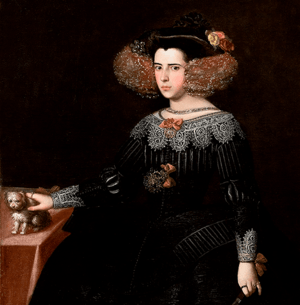
Eventually, fighting happened in three areas. But most of the action was on the northern front, near Galicia. The central border between Portuguese Alentejo and Spanish Extremadura also saw much fighting. The southern front, where the Portuguese Algarve meets Spanish Andalusia, was a logical target for Portugal. However, it was never the main focus of a Portuguese attack. This was probably because the Portuguese queen, Luisa de Guzmán, was the sister of the Duke of Medina Sidonia, a powerful noble in Andalusia.
Tiring War and Problems
At first, Spain fought a defensive war. Portugal also felt no need to take Spanish land to win. So, it too was happy to fight defensively. Campaigns usually involved correrias (cavalry raids). These raids aimed to burn fields, rob towns, and steal large groups of enemy cattle and sheep. Soldiers and officers, many of them mercenaries, were mostly interested in loot. They often left the army. For long periods, neither side had enough men or money for big campaigns. When actions did happen, they were often for political reasons. For example, Portugal needed to impress possible allies.
The war became a cycle of destruction. By December 1641, Spaniards often complained that "Extremadura is finished." Tax collectors, recruiting officers, and soldiers living in homes were hated. Raids by Spanish and foreign troops were feared as much as enemy raids. In Extremadura, local militias did most of the fighting until 1659. The absence of these part-time soldiers badly hurt farming and local money. Often, there was no money to pay soldiers or their commanders. So, the Spanish king ignored smuggling, illegal trade, and disorder. These problems were common on the border. Similar issues also existed among the Portuguese.
Second Stage: Defensive Standoff
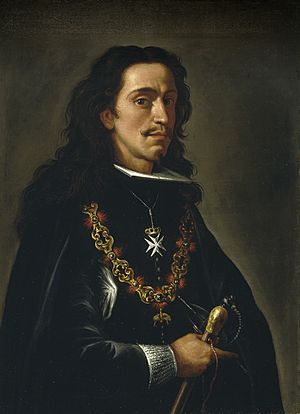
The war was also very costly. In the 1650s, over 20,000 Spanish troops were in Extremadura alone. This was compared to 27,000 in Flanders. Between 1649 and 1654, about 29% of Spain's defense money went to fighting Portugal. This amount increased during the major campaigns of the 1660s. Portugal could pay for its war efforts by taxing the spice trade from Asia and the sugar trade from Brazil. It also received some help from Spain's European enemies, especially France and England.
The 1650s were not decisive militarily. But they were important for politics and diplomacy. The only exception was the Battle of the Lines of Elvas in 1659. The death of John IV in 1656 led to his wife becoming regent. This was followed by problems with who would rule next and a palace coup in 1662. Despite these internal issues, Portugal's position improved. The Dutch were expelled from Brazil (1654). A treaty was signed with England (also in 1654). This gave Portugal needed protection against a naval attack on Lisbon.
However, Portugal still wanted a formal agreement with France. But this goal continued to escape them. Portugal's weakness and isolation were clear. They were almost completely left out of the peace talks for the Treaty of Westphalia (1648).
With this treaty and the end of fighting in Catalonia in 1652, Spain was ready to focus on Portugal again. But Spain lacked men, resources, and especially good military commanders.
Third Stage: Portuguese Victory
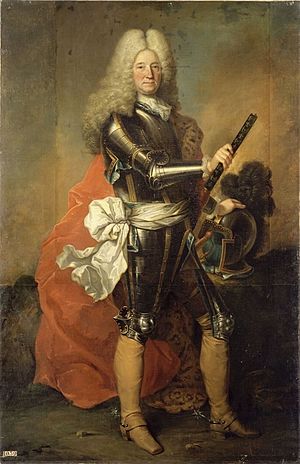
By 1662, Spain was determined to end the war. John of Austria the Younger, Philip IV's son, led 14,000 men into Alentejo. The next year, they captured Évora, a major city in the region.
The Portuguese, led by António Luís de Meneses, 1st Marquess of Marialva, got a boost. A British brigade of 3,000 soldiers arrived in August 1662. Many were veterans of the English Civil War and the Dutch Revolt. For King Charles II of England, this was a good way to get rid of soldiers from Cromwell's army. They were led by the German soldier Friedrich Hermann von Schönberg, Count of Mértola. This brigade, under Schomberg's leadership, was key to Portugal winning back its independence.
They defeated the Spanish in a major battle at Ameixial on June 8, 1663. This forced John of Austria to leave Évora and retreat across the border. He suffered heavy losses.
Portugal now had about 30,000 troops in the Alentejo-Extremadura area. But they could not get the Spanish into another major battle until June 1665. A new Spanish commander, the marquis of Caracena, took over Vila Viçosa with about 23,000 men. These included new soldiers from Germany and Italy.
The Portuguese relief column, led by António Luís de Meneses and Schomberg, met them at Montes Claros on June 17, 1665. The Portuguese infantry and artillery broke the Spanish cavalry. The Spanish force lost over 10,000 men, including dead and prisoners. Soon after, the Portuguese retook Vila Viçosa. These were the last major battles of the war.
Both sides went back to small skirmishes. Portugal, with help from its English ally, had sought a truce. But after the clear Portuguese victory at Montes Claros and a Franco-Portuguese treaty in 1667, the Spanish Habsburgs finally agreed. On February 13, 1668, they recognized the House of Braganza as Portugal's new ruling family.
Key Battles of the War
The five main battles of the war were:
- Battle of Montijo on May 26, 1644
- Battle of the Lines of Elvas on January 14, 1659
- Battle of Ameixial on June 8, 1663
- Battle of Castelo Rodrigo on July 7, 1664
- Battle of Montes Claros on June 17, 1665
The Portuguese won almost all of these battles. Peace was made with the help of England. The Treaty of Lisbon (1668) was signed in 1668.
Timeline of Important Events

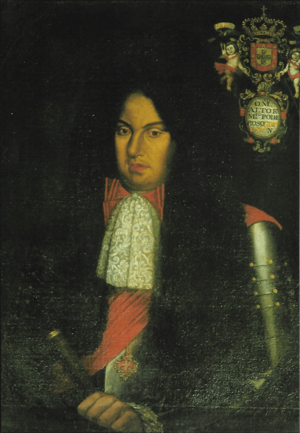
- 1640: A small group of plotters stormed the royal palace in Lisbon. They removed the Vicereine of Portugal, Margaret of Savoy, on December 1, 1640. She tried to calm the people during protests in Lisbon's main square, but it didn't work. The Duke of Bragança, the most important noble family in Portugal, accepted the throne as John IV of Portugal that same day. John's entire time as king was focused on keeping Portugal independent.
- 1641: A counter-revolution by the Portuguese Inquisition failed. Its leaders were executed. Miguel Luís de Menezes was executed for supporting the Habsburgs' claim to the Portuguese throne.
- 1641: Portugal signed alliances with France (June 1, 1641) and Sweden (August 1641).
- 1641: Portugal and the Dutch Republic signed a 'Treaty of Offensive and Defensive Alliance' (the Treaty of The Hague (1641)) on July 12, 1641. Neither side fully followed the treaty. So, it didn't affect Portuguese lands in Brazil and Angola that the Dutch occupied.
- 1641: The Dutch began occupying São Tomé and Ano Bom on October 16, 1641. They stayed until January 6, 1649. This clearly broke the agreement made with Portugal just three months earlier.
- 1641: Portugal was driven out of Malacca by the Dutch.
- 1642: The Dutch took over all of the Portuguese Gold Coast (now Ghana).
- 1643: At the Battle of Rocroi (May 19, 1643), in the Ardennes, the French defeated the Spanish.
- 1644: The Battle of Montijo near Badajoz, between the Portuguese and the Spanish, was fought on May 26, 1644.
- 1644: The Portuguese city of Elvas survived a nine-day siege by Spanish troops.
- 1648: The Sultan of Oman, allied with the Dutch, captured Muscat. This had been a Portuguese trading post on the Arabian Peninsula.
- 1648: Portuguese troops from the colony of Brazil under Salvador Correia de Sá landed in Angola. They retook Luanda and expelled the Dutch. This restored the African colony to Portugal.
- 1649: The Dutch were driven out of São Tomé.
- 1654: The Anglo-Portuguese treaty between John IV and Oliver Cromwell was signed in Westminster. John agreed to protect English traders in Portugal. He also allowed them to use their own bible and bury their dead according to Protestant customs, even in Catholic Portugal.
- 1654: Portuguese troops from Brazil drove the Dutch out of the large plantation colonies in northeastern Brazil. This restored Portugal's control over its South American lands.
- 1656: Portugal lost control of Colombo in Portuguese Ceylon to the Dutch.
- 1656: John IV died on November 6, 1656, after ruling for 15 years. His queen, Luisa de Guzman (1613–1666), then ruled as regent for their son, Afonso VI of Portugal. She began seeking peace with Spain.
- 1658: The Dutch took Jaffnapatam, Portugal's last colony in Ceylon.
- 1659: The Battle of the Lines of Elvas was fought on January 14, 1659. Portuguese troops, led by the marquis of Marialva, António Luís de Meneses, and Sancho Manoel de Vilhena, won a big victory over the Spanish.
- 1659: The Spanish besieged the Portuguese town of Monção. The town fell on February 7.
- 1659: The Treaty of the Pyrenees was signed on November 7, 1659. This ended Spain's long war with France. Spanish troops were now free to fight the Portuguese 'rebellion'. The Spaniards besieged Elvas, but António Luís de Meneses drove them off again.
- 1660: When Charles II of England was restored to the throne in England, the Queen-Regent re-negotiated the 1654 treaty. Portugal could recruit soldiers and horses in England for the fight against Spain. They could also hire 4,000 mercenaries in Scotland and Ireland. And they could charter 24 English ships to carry them. The English force received English weapons in Portugal and was guaranteed freedom of religion.
- 1660: The English began to control the trade in port wine from Portugal. This happened after a political dispute with the French denied them Bordeaux wines. Brandy was added to Portuguese wines to make them stronger for the Atlantic journey. Along with Charles II's return, the "port connection" had a growing positive effect on Anglo-Portuguese relations.
- 1661: Bombay and Tangier were given to England on June 23, 1661. This was part of the dowry for Afonso's sister, Catherine of Braganza. She married King Charles II of England on May 25, 1661. Besides Bombay and Tangier, Catherine brought two million gold pieces to London. This wedding debt burdened Portugal's treasury for the next 50 years. The marriage to a Protestant king was very unpopular with some Portuguese nobles who preferred an alliance with France. This led to pro-English and pro-French groups at the Portuguese court.
- 1661: English mediation helped the Netherlands agree, on August 6, 1661, to Portuguese rule in Brazil. In return, the Netherlands got full control of Ceylon and eight million guilders. This agreement was made official in the Treaty of The Hague (1661).
- 1662: Soon after Afonso VI became an adult, Luís de Vasconcelos e Sousa, 3rd Count of Castelo Melhor, saw a chance to gain power. He became friends with the king, who had mental difficulties. He convinced the king that his mother, Luisa of Medina-Sidonia, was trying to steal his throne. As a result, Afonso claimed his right to rule and sent his mother to a convent. The king made Castelo Melhor his secret notary. In this role, Castelo Melhor became the unofficial "dictator of Portugal" because of the king's weakness.
- 1662: Castelo Melhor started the final (and successful) part of the Portuguese Acclamation War. He was helped by the Count of Mértola. The Count brilliantly led the international mercenary army, which had been put together with England's help.
- 1663: The Battle of Ameixial was fought on June 8, 1663. The Spanish army, led by John of Austria the Younger, had taken the Portuguese city of Évora. Less than three weeks later, they were soundly defeated by Sancho Manoel de Vilhena and Count of Mértola.
- 1663: The Dutch drove the Portuguese from the Malabar coast. This was a clear violation of their 1661 treaty.
- 1663: The Siege of Évora happened when the Portuguese army, led by Sancho Manoel de Vilhena and the Count of Mértola, retook the city from the Spanish. They had very few casualties. The entire Spanish army there surrendered.
- 1664: The Battle of Castelo Rodrigo was fought on July 7, 1664. A regional military commander, Pedro Jacques de Magalhães, defeated the Duke of Osuna.
- 1664: The Siege of Valencia de Alcántara resulted in Portugal successfully taking the Spanish town of Valencia de Alcántara in July 1664.
- 1665: Portugal won again at the Battle of Montes Claros (on June 17, 1665). In this battle, António Luís de Meneses and Schomberg defeated the Spanish army led by the Marquis of Caracena. Spain stopped fighting, but a real peace treaty wasn't signed for another three years. Montes Claros is considered one of the most important battles in Portuguese history.
- 1666: To create an alliance with France, Castelo Melhor arranged for Afonso VI to marry Marie Françoise of Nemours. She was the daughter of the Duke of Nemours. But this marriage did not last long.
- 1667: Marie Françoise asked for her marriage to Afonso VI to be cancelled. The Church granted the annulment.
- 1667: King Afonso VI, Castelo Melhor, and his pro-French group were overthrown. This was done by the king's younger brother, Pedro, Duke of Beja (who later ruled as Pedro II of Portugal). Pedro first made himself his brother's regent. Then he arranged Afonso's exile to the island of Terceira in the Azores. The reason given was that Afonso was not able to govern. Castelo Melhor fled into exile, ironically choosing to live in England.
- 1667: The French alliance was in danger because Afonso's marriage was cancelled. But Pedro strengthened his political position by marrying his brother's former queen.
- 1668: The Treaty of Lisbon (1668) with Spain ended 28 years of war. The regent of Spain, Mariana of Austria, acting for her young son Charles II of Spain, finally recognized the Portuguese king as legitimate. Portugal kept all its remaining overseas colonies, except for Ceuta on the North African coast. Ceuta had not recognized the Braganza Dynasty during the war.
What Happened After the War
For Portugal, the war clearly established its independence from Spain. It showed that Portugal could defend itself, even if it was difficult. Its victories on the battlefield brought back a strong sense of Portuguese nationalism.
Economically, Portugal's independence allowed it to continue its path as a trading empire. In the 17th century, its economy relied mostly on trading tobacco and sugar, and exporting salt. In the 18th century, while these goods were still important, the Portuguese economy also grew with trade in enslaved people, gold, leather, and wine. Portuguese trade, centered in the busy port of Lisbon, was greatly influenced by English and Dutch business and by the colonial economy in Brazil.
Luís de Meneses, the Count of Ericeira, advised the prince regent on economic matters. He suggested developing a local textile industry, similar to the Flemish model. Factories were set up in Covilhã, an area in central Portugal with easy access to sheep and clean mountain water. However, these factories were not popular with local consumers or traditional weavers. Meanwhile, French efforts to control the silk market hurt Portuguese attempts to develop their own silk industry.
More importantly, after 1668, Portugal wanted to be different from Spain. It looked to Western Europe, especially France and England, for new ideas and skills. This was part of a slow process of becoming "less Iberian." Portugal strengthened its cultural and political independence from Spain. Portuguese nationalism, boosted by war victories, led to negative feelings towards Spain and Spanish things. By this time, Portuguese society had two main parts: those who joined the Europeanization process (the "political nation") and the majority who remained largely unchanged, staying out of politics.
Macau, the Portuguese colony in the Far East, stayed loyal to the Portuguese king throughout the war. Because of this, King John IV of Portugal gave it the title in 1654: “Cidade do Nome de Deus, Macau, Nao Ha Outra Mais Leal”. This means “City by the Name of God, Macau, There Is None More Loyal.”
See Also
- 1580 Portuguese succession crisis
- Dutch-Portuguese War, 1602–1663
- History of Portugal (1640–1777)
- Monument to the Restorers
- Restauradores Square


